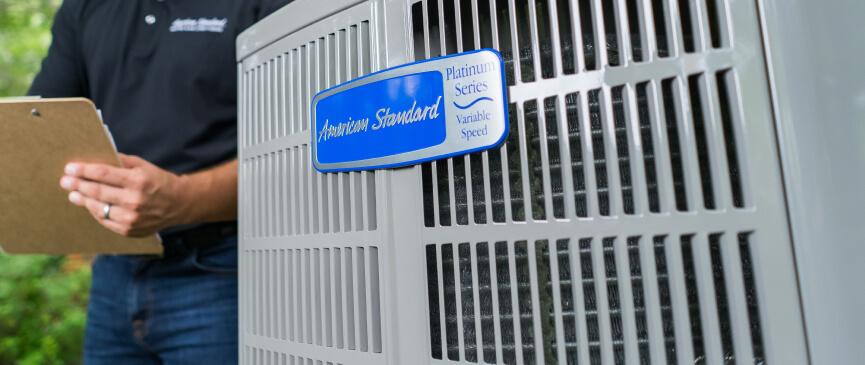What is SEER?
Learn more about SEER, now updated to SEER2, an important energy rating associated with your cooling system.

Your home and energy needs are unique, which means your SEER rating may change depending on what’s most important to you in a heating and cooling system.
By Anne Fonda
SEER stands for Seasonal Energy Efficiency Ratio. This energy efficiency rating represents the ratio developed when the cooling output of the air conditioning system over an average cooling season is divided by the total energy used. More simply, SEER is representative of how much energy and money the unit requires to cool effectively over a single year.
The higher the ratio, the less energy the unit uses to produce the right amount of cooling. That means the higher the SEER rating a unit has, the more efficient it is at cooling and dehumidifying your home. More efficient systems save you money on your cooling bills.
Think of it in terms of shopping for a new car and looking at its fuel efficiency. An SUV that gets 38 combined city/highway mpg will save you a lot of money on gas compared to an SUV with a combined 17 mpg.
SEER vs SEER2
Older central air conditioners and heat pumps had a SEER rating. However, on January 1, 2023, the Department of Energy (DOE) implemented new energy efficiency requirements for newly manufactured HVAC units. As a result, SEER became SEER2. Other HVAC energy efficiency terms changed as well.

For packaged systems, the minimum requirements are nationwide, as follows:
Packaged HP
- 13.4 SEER2
- 6.7 HSPF2
Packaged AC
- 13.4 SEER2
- 10.6 EER2
The goal of the new heating and cooling efficiency standards is to lower energy consumption by increasing energy efficiency. A bonus for homeowners: You can achieve long-term energy cost savings by buying a more efficient HVAC system.
Why a SEER2 rating matters
Air conditioning units and heat pumps built 10 to 15 years ago typically have a SEER rating between 8 and 10. Our units today have a SEER2 ranging from 13.4 to up to 23.6. You can find the SEER rating of an older unit in one of the following ways:
- Check the yellow and black Energy Guide sticker on the outdoor unit.
- Look at the paper attached to the air handler or furnace inside your home.
- Locate the model and serial number of the unit and contact the manufacturer to get the SEER rating.
Replacing an AC unit or heat pump that’s 10 or more years old could save you as much as 20-40% on your energy costs each year.
The many different models operate at different efficiency levels and cover a variety of price points. When you consider a new HVAC system for your home, don’t shy away from air conditioners or heat pumps with a lower SEER2. If you have mild, short summers, you may not need a highly efficient workhorse of a unit.
There are many factors, including your current ductwork and home insulation, that will also affect the unit’s performance. Even with a high SEER2 rating, it’s still helpful to use other energy-saving measures. Check out our Green Guide for some tips.
The more cooling stages, the higher the SEER2
In both air conditioners and heat pumps, the SEER2 is related to how many cooling stages the AC unit or heat pump has.
Single-stage
Lower SEER2 units typically operate on a single speed, which leads to the AC or heat pump turning on and off frequently, which can create uneven cooling throughout your home. In general, a smaller number of cooling stages and lower SEER2 make a unit less efficient than others, but it also offers a lower up-front cost. However, because of the frequent starting and stopping, the unit may cost more to operate in the long run.
Two-stage
A two-stage compressor, sometimes referred to as a dual-stage compressor, has two levels of operation: high and low. Two stages of output allow the compressor to use less energy when needed. For example, on mild-weather days, the compressor may operate primarily on the low setting, requiring less energy and possibly lowering your monthly energy bill.
Multi-stage
A multi-stage compressor system offers an energy-efficient bridge between a two-stage system and a variable-speed system. It has more speeds than high and low and can offer more consistent cooling, or heating and cooling, in the case of a heat pump.
Variable-speed
Finally, a variable-speed compressor can operate at even more speeds. These variable speeds can support the unit in customizing the energy output needed to keep your home comfortable. Variable-speed compressors rarely shut off as they blow a constant stream of cool air into your home to maintain a consistent temperature. These units may cost more upfront but they offer long-term savings on your monthly energy bills.
Learn more about single-stage vs two-stage vs. variable-speed compressors.
Benefits of a high SEER2 rating
The higher the SEER2 rating, the larger the financial investment, and the greater the potential long-term energy savings. Benefits of a higher SEER2 include:
Cost savings
A higher SEER2 rating indicates the unit can operate more efficiently in certain conditions. Less energy used can mean greater savings on your monthly utility bill. The amount you could save each month will depend, among other variables, on the difference between the SEER2 ratings of your old unit and the new cooling unit, your usage habits, how well your home is insulated, and more.
Greater indoor comfort
For some homeowners, summer months mean more than just heat. Humidity can create discomfort within a home that isn’t being cooled by an energy-efficient American Standard unit.
Choosing an air conditioner or heat pump with a higher SEER2 rating means that coming indoors offers a reprieve from sweltering heat and humidity outside your door. Greater indoor comfort is created by a two-stage, multi-speed, or variable-speed compressor and a variable-speed blower.
Reduced environmental impact
Create a smaller carbon footprint with an air conditioning or heat pump system with a higher SEER2 rating. In addition to using less energy, some new cooling units use next-generation refrigerants. Having a new unit installed at your home means you’re contributing to a greener space for future generations.
Best SEER2 for your home
The best SEER2 rating for your home HVAC system will be different than that for a homeowner in a different region of the country. A SEER2 rating over 14 may create a comfortable indoor environment for a home in an area with shorter, milder summers, but you’ll also want to consider the size of your home, quality of insulation, and current ductwork.
You should also know that ENERGY STAR®- qualified air conditioners and heat pumps are not only more efficient, but when paired with the right indoor unit, they may be eligible for federal energy tax credits and heat pump rebates.
As of 2025, the latest ENERGY STAR® requirements vary based on whether the unit is an air conditioner, a heat pump, or a packaged unit, as follows.
Split-system air conditioners
- SEER2 at or above 17
- EER2 of 12 or above
Path A heat pumps
- SEER2 > 16
- EER2 > 9.8
- HSPF2 > 8.5
- COP @ 5°F > 1.75
- Capacity Ratio > 60% at 5F/47F
Path B heat pumps
- SEER2 > 16
- EER2 > 11
- HSPF2 > 8.0
- COP @ 5°F > 60%
- Capacity Ratio > 45% at 5F/47F
Packaged heat pumps
- SEER2 > 15.2
- EER2 > 10
- HSPF2 > 7.2
- COP @ 5°F > 1.75
- Capacity Ratio > 45% at 5F/47F
Visit our offers, tax credits, and rebates page to see the incentives available to you.
Schedule a free quote
If you’re in the market for a new HVAC system, contact your local American Standard dealer for a home assessment and expert product recommendations. Whether you’re in Houston battling high humidity or you’re having a hard time coping with Chicago’s increasingly hot and sticky summers, we can help.
For over 100 years, we’ve designed and manufactured some of the most awarded, well-engineered heating and cooling equipment and earned a reputation for doing things right.
Anne Fonda, Content Writer
A Content Writer with Trane Technologies, Anne Fonda researches topics and writes for Trane® and associated residential HVAC brands. She works in collaboration with Trane Technologies subject matter experts, offering easy-to-understand, informative content on complex topics. Her goal is to help consumers make informed decisions on the products and services they need.
She has written for HVAC and other service provider websites for over 16 years. Before transitioning to web content writing, Anne had a 14-year stint as an award-winning journalist. She graduated cum laude from the University of Missouri-Columbia School of Journalism.
When she’s not working, Anne enjoys playing word games, reading, gardening, spending time with family, and visiting gardens and museums.
Expert review by Mark Woodruff, Senior Product Manager, Ducted Outdoor






